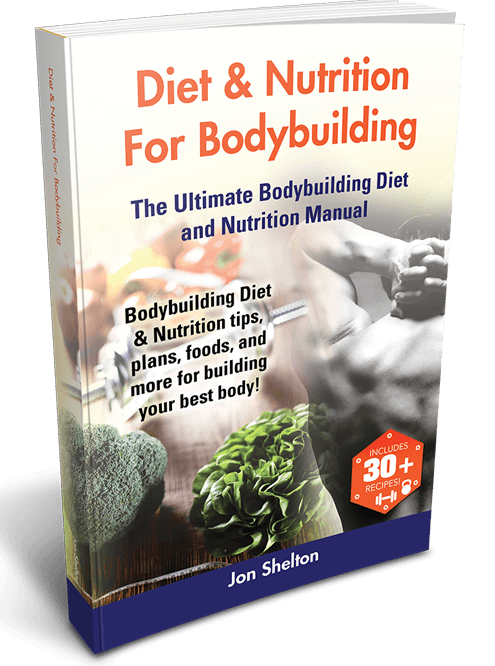CHAPTERS
Navigate to chapter
► Chapter One: What is Bodybuilding?
► Chapter Two: The Three Core Principles
► Chapter Three: Bulking and Cutting
► Chapter Four: Nutrition for Bodybuilding
► Chapter Five: What to Eat and When
► Chapter Six: Fat-Burning Recipes for Cutting
► Chapter Seven: Muscle-Building Recipes for Bulking
Chapter Two: The Three Core Principles

There are a variety of different bodybuilding programs out there and the program you choose will depend on what your goals are. For any bodybuilding program, however, the three core principles are the same: smart training, quality nutrition, and adequate rest. In this chapter you will learn some basic tips about how to train your body correctly as well as information about fueling your body properly with quality nutrition You will also receive some valuable information about incorporating recovery periods into your program to maximize your gains.
Many bodybuilders will tell you that bodybuilding isn’t so much about training hard as it is training smart. You can spend hours in the gym every day of the week but you won’t see any real progress unless you are training correctly. Before getting into the basics about smart training, you should familiarize yourself with the process of muscle growth. If you do not already know and understand this process, you may be surprised to learn how muscle growth actually works – it is not simply a matter of your muscles increasing in size.
Your body contains several different types of muscles – visceral muscle, cardiac muscle, and skeletal muscle. Visceral muscle is the kind of muscle found in your organs and blood vessels. This type of muscle is the weakest of all your muscles and it is controlled by the unconscious part of your mind – this is why it is sometimes called “involuntary muscle”. Cardiac muscle is only found in the heart and its job is to pump blood throughout your body. This type of muscle is also involuntary – you cannot consciously control this type of muscle the way you can the muscles in your arms or legs, for example.
The only voluntary muscle in your body is your skeletal muscles – these are the muscles that contract to move certain parts of your body according to your will. There are 650 different skeletal muscles in the body and they are all controlled by signals they receive from your motor neurons. When you activate your skeletal muscles you call them to contract and the more you do that, the greater control you have over your muscles and the stronger they get.
When it comes to the growth of your skeletal muscles, there are two different kinds of growth – hypertrophy and hyperplasia. Hypertrophy is also divided into two categories: sarcomere hypertrophy and sarcoplasmic hypertrophy. Sarcomere hypertrophy occurs when the contracting parts of your muscles, the sarcomeres, increase in size. Sarcoplasmic hypertrophy is the result of an increase in the non-contracting portion of your muscles. Hyperplasia, on the other hand, involves the increase in the number of muscle fibers, not the size.
As you work out, your muscles develop tiny tears in the muscle fibers. After the workout, your body repairs or replaces those damaged muscle fibers, often by fusing muscle fibers together to form a new strand – this is how sarcomere hypertrophy occurs. Of course, the only way to create the kind of muscle damage that leads to growth is to lift progressively heavier weights. Your body adapts to certain exercises the more you do them, so if you keep lifting the same amount of weight, you will maintain your current level of muscle and strength. That is where smart training comes into play.
Now that you understand the process of muscle growth you may be wondering what the best way to achieve it is. According to Bodybuilding.com, the goal of lifting weights is to encourage adaptation – you want your body to respond to the physical stress of lifting weights by increasing the size and number of your muscle fibers in order to adapt to the type of work you are doing. Then, once your body adapts to that level of performance, you increase the amount of physical stress by increasing the amount of weight and/or the number of sets and repetitions to encourage your body to adapt to the new level.
It is important to realize that hormones play a major role in muscle growth and repair. Testosterone is the main hormone associated with muscle growth because it helps to increase protein synthesis and to minimize protein breakdown. Unfortunately, most of the testosterone in the body is bound and unavailable for use. The best way to make that testosterone available is through strength training. When you work your muscles, testosterone helps to stimulate a response in your growth hormones, causing more neurotransmitters to gather at the site of the damaged muscle fibers to activate tissue growth.
If you were to ask a bodybuilder for advice on how to start lifting weights, he would probably tell you make sure that you work each major muscle group in your body once a week. This is the most basic principle of strength training and it is a simple enough concept for beginners to understand. The main muscle groups you want to work are your chest, back, shoulders, legs, and arms. Some bodybuilders divide these muscle groups down further, breaking the legs category into quadriceps and hamstrings as well as the arms category into biceps and triceps.
If the goal is to work each of these muscle groups once per week, there are different ways to go about doing that. If you refer back to the previous chapter, you will remember that some of the workout programs involved isolated muscle group exercises while others were built around compound exercises, working multiple muscle groups at a time. You can customize your workout plan depending on how many days you want to work out each week and which muscle groups you want to target. In order to maximize your gains, of course, you will also need to optimize your nutrition and your recovery.
Nutrition for bodybuilding is very similar to the business concept of supply and demand – in order to fuel muscle growth and repair, your body demands a supply of certain nutrients. Similar to the concept of adaptation discussed in the last section, you can work out five days a week for two hours a day but unless you offer your body the right nutrition, you will not see any gains. Quality nutrition for bodybuilding is all about meeting the right macronutrient ratios.
Macronutrients are the nutrients that provide energy in the form of calories – this includes protein, fat, and carbohydrate. Vitamins and minerals are considered micronutrients – they are necessary for balanced nutrition but they do not contain any calories. Protein provides your body with 4 calories of energy per gram, which is the same as carbohydrate. Fat, on the other hand, provides 9 calories per gram which makes it a more highly concentrated source of energy.
Your body needs protein to sustain muscle growth and tissue repair – it also plays a role in immune function and hormone balance. Plus, you need plenty of protein in your diet to preserve your lean muscle mass. Fat gets a bad rap for causing weight gain, but it plays an important role in nutrition for bodybuilding. Fat is the most highly concentrated form of energy, plus it is necessary for absorbing certain vitamins. Carbohydrate is a less highly concentrated form of energy than fat, but it is more readily available and easier for the body to breakdown for immediate use.
The required amount of each macronutrient your body needs depends on a variety of factors. To sustain muscle growth and repair, however, you should follow the nutrition tips below:
Continue Reading…
Want to read the entire thing?

